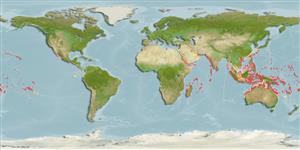Common names from other countries
>
Anguilliformes (Eels and morays) >
Ophichthidae (Snake eels) > Myrophinae
Etymology: Scolecenchelys: Greek, skolex = worm (1855) + Greek, enchlys, -yos = eel (Ref. 45335).
More on author: Bleeker.
Environment: milieu / climate zone / depth range / distribution range
Ecologia
marinhas associadas(os) a recifes; intervalo de profundidade 0 - 30 m (Ref. 86942). Tropical; 32°N - 28°S
Indo-Pacific: widespread, from East Africa to Samoa, north to Okinawa-jima Island, Japan, excluding the Red Sea and the coast of Australia.
Tamanho / Peso / Idade
Maturity: Lm ? range ? - ? cm
Max length : 38.0 cm TL macho/indeterminado; (Ref. 1602)
Descrição breve
Chaves de identificação | Morfologia | Morfometria
Vértebras: 118 - 135. This species is distinguished by the following set of characters: 2 infraorbital pores found at the postorbital area; median ventral groove on the snout absent; acute snout; rictus of mouth slightly posterior to a vertical line through the posterior margin of the eye; pointed conical teeth on upper jaw and vomer, arranged biserially on upper jaw, uniserially on vomer; dorsal-fin origin posterior to a vertical line through the anus, horizontal distance between the origin and the vertical line 13-55% HL; tail 54-58% TL; total vertebrae 118-135, predorsal 51-57 and preanal 47-52; mean vertebral formula (MVF) 53.9-50.0-128.6 (Ref. 92899).
Lives in loose sand and fine gravel (Ref. 1602). Benthic (Ref. 58302) and burrowing species found in inshore waters (Ref. 7300, 75154). Feeds on small fishes and crustaceans (Ref. 89972).
Life cycle and mating behavior
Maturities | Reprodução | Spawnings | Egg(s) | Fecundities | Larvas
Hibino, Y. and S. Kimura, 2015. Revision of the Scolecenchelys gymnota species group with descriptions of two new species (Anguilliformes: Ophichthidae: Myrophinae). Ichthyol Res (Ref. 104540)
Categoria na Lista Vermelha da IUCN (Ref. 130435)
CITES (Ref. 128078)
Not Evaluated
Ameaça para o homem
Harmless
Utilização humana
Ferramentas
Relatórios especiais
Descarregue XML
Fontes da internet
Estimates based on models
Preferred temperature (Ref.
115969): 24.9 - 29.2, mean 28.1 (based on 2563 cells).
Phylogenetic diversity index (Ref.
82804): PD
50 = 0.5000 [Uniqueness, from 0.5 = low to 2.0 = high].
Bayesian length-weight: a=0.00076 (0.00029 - 0.00199), b=3.06 (2.83 - 3.29), in cm Total Length, based on LWR estimates for this (Sub)family-body shape (Ref.
93245).
Nível Trófico (Ref.
69278): 4.1 ±0.7 se; based on size and trophs of closest relatives
Resiliência (Ref.
120179): Elevada, tempo mínimo de duplicação da população menor que 15 meses (Preliminary K or Fecundity.).
Fishing Vulnerability (Ref.
59153): Low to moderate vulnerability (28 of 100).
